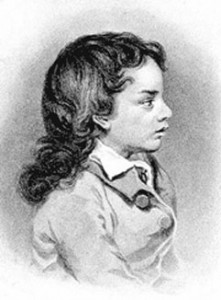 Born in Bristol in 1752, Thomas Chatterton was one of the most enigmatic characters of 18th Century poetry, mostly in part because he took his own life at the tender age of just 17 and wrote the fake ‘Rowley poems’ that caused such controversy at the time. He became a the focal point for many later poets from the Gothic era including Shelley and Dante Gabriel Rossetti because of his life of poverty that was largely lived in the imagination, as well as his untimely suicide.
Born in Bristol in 1752, Thomas Chatterton was one of the most enigmatic characters of 18th Century poetry, mostly in part because he took his own life at the tender age of just 17 and wrote the fake ‘Rowley poems’ that caused such controversy at the time. He became a the focal point for many later poets from the Gothic era including Shelley and Dante Gabriel Rossetti because of his life of poverty that was largely lived in the imagination, as well as his untimely suicide.
Rumor has it that Chatterton did not take to reading until he found an illuminated manuscript in an old oak chest at which point he did nothing but read and developed a yearning for fame as a poet. At eight years old he was sent to a charitable school where he was taught the basics, possibly in preparation for going into one of the professions of the community, law or commerce. When he left he became a clerk and was soundly beaten by his employer because he liked to write poetry.
Chatterton was enamored of the local Gothic church of St Mary Redcliff and particularly the story of Thomas Rowley which would later figure highly in the myth that would surround him. He was a sensitive child, given to sitting alone and in long contemplations and he wrote from the age of 11, publishing some works in a local journal.
Though not yet 12 years old, he wrote Elinore and Juga, showing it to an associate but pretending that it had been written by a medieval poet. It was about this time that he assumed the persona of Thomas Rowley, a monk in the 15th Century, using it to publish many poems and essays. Chatterton contacted the writer Horace Walpole who was famous for the publication of his Gothic novel The Castle of Otranto. Walpole promised to publish the fake Rowley poems until he began to suspect that they were forgeries and sent Chatterton away.
For a while Thomas Chatterton moved to London, trying to make his way as a writer. By 1770 he had sent several contributions to the Middlesex Journal and had written a satirical but portentous Last Will and Testament that professed he was going to end his life the next day. He also wrote for the Town and Country Magazine and earned a little money which he used to buy gifts for his mother and sister.

He entered a period of high productivity and revived his fake 15th Century poet Rowley, writing Excelente Balade of Charitie. Those surrounding him noted that he was prone to not eating and spent a lot of his time in solitude. He garnered a good deal of flattery from editors from around the capital but little came his way in remuneration. In August of 1770, he went up to his attic room with a bottle of arsenic, drank it and ended his own life.

His death was barely noticed at the time and it wasn’t until his Rowley poems were discovered as forgeries that his myth began to grow. Horace Walpole who had initially sent Chatterton away was publicly vilified for his behavior and it took some twenty years for the author to restore his reputation. In the meantime, Chatterton became the archetypal tragic Gothic poet hailed by the likes of Shelley, Coleridge, Keats, and later Oscar Wilde.

